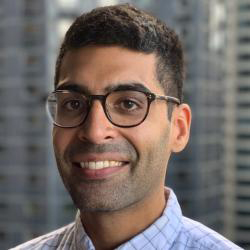
Assistant Professor
CM
Office: Knudsen 6-130N
Phone: 310-825-4079
Email:
Website
Anshul Kogar is an experimental condensed matter physicist. He joined the faculty and started his research lab at UCLA in the fall of 2019. He received his B.S. in Physics from UCLA and obtained a Ph.D. in condensed matter physics at the University of Illinois at Urbana-Champaign. During his Ph.D., while working in the lab of Prof. Peter Abbamonte, he and co-workers developed a spectroscopic technique known as momentum-resolved electron energy loss spectroscopy (M-EELS). They used this technique to provide substantial evidence for exciton condensation in 1T-TiSe2. From 2016-2019, Professor Kogar was a postdoctoral researcher in the group of Nuh Gedik at MIT. There, he worked on using intense, ultrafast light pulses to induce non-equilibrium states of matter. In particular, he showed, using ultrafast electron diffraction, that photons can be used to induce a charge density wave in LaTe3.
Non-equilibrium states and properties of matter
The lab uses intense light pulses to discover, study and control various states of matter including charge density waves, superconductors and other exotic phases. At a high level, the lab seeks to answer the following questions pertaining to this topic: (1) What kinds of phases of matter exist away from thermal equilibrium? (2) Can the different degrees of freedom of light, i.e. the polarization, wavelength, orbital angular momentum, etc., be used to control various phases? (3) Can light be used to create and manipulate topological defects in ordered phases? To answer these questions, the group uses ultrafast electron diffraction and time-resolved second harmonic generation.
Coulomb energy
The main question asked here is: to what extent does the Coulomb interaction between electrons determine the ground state and its corresponding properties in strongly correlated electron systems? The lab seeks to develop the spectroscopic tools to quantitatively measure the Coulomb energy change across phase transitions in order to place various constraints on how solids save energy. This is particularly pertinent in the field of unconventional superconductivity, where there is still much debate about where the energy is saved as a material undergoes a change from its “normal” to superconducting phase. As part of the ultrafast electron diffraction beamline, the lab is designing transmission electron energy loss spectroscopy instrumentation to perform such experiments.
Professor Kogar is always happy to speak to students that are interested in undergraduate, graduate and postdoctoral research projects. He also maintains a blog, This Condensed Life, that discusses various topics in quantum and condensed matter physics.